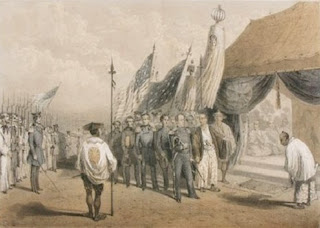This is a well-organized article.
This writing finely describes the quintessence
of TPP.
But, I don’ think that we will have this
kind of outcome. This is because in the spiritual
world evil has completely perished. As the
material world is a reflection of the spiritual world, all evil will finally
perish in the material level, too.
However, from the viewpoint of deities, the
majority of people who yield to the powerful without doing anything and live a safety-oriented
life are considered as evil men, and they will perish. It is not safety but justice, good or truth
that we have to seek. As things stand
now, only one of 1,000 human beings will have a chance to survive.
Masatoshi
Takeshita
March
18, 2013
English translation of an excerpt from a
Japanese article: Soon North Wind Will Blow – March 17, 2013 –
TPP,
Ultimate Unequal Treaty, Deprives Nation State of Sovereignty: Iwakami
[Extra edition: Yasumi Iwakami] Naosuke Ii was murdered and Shigeru Yoshida survived. What will happen to Shinzo Abe? March 16, 2013
The Japan-US relationship is, after all, the
imposition of unequal treaties and the history of subordination and resistance
to them.
“The third opening of a
country” is the perfect name for TPP.
This is nothing but the imposition of the third unequal treaty, further loss
of national sovereignty and deepened subordination to U.S.
The first opening of a
country was the Treaty of Amity and Commerce between the United States of
America and the Empire of Japan concluded in 1858.
The treaty was concluded five years after Perry
and his four black ships came to Uraga to call for Japan to open the country in
1953. It was an unequal treaty in which
Japan had no tariff autonomy.
Why did the Shogunate bow
to U.S.’s demand and conclude such an unequal treaty?
This is because American
Consul General Townsend Harris expertly threatened Japan, hinting at the
possibility that England, which was conducting a war of invasion against the
Qing Dynasty, France and other countries would invade Japan. Then he explained the
need for conclusion of a treaty with US for security of Japan.
This is rarely different
from the logic that it is indispensable to strengthen the Japan-US alliance for
security of Japan today and to that end, it is important to conclude the TPP.
Naosuke Ii, a senior aide in the Tokugawa
Shogunate, invoked the wrath of anti-foreign fanatics for concluding the Treaty
of Amity and Commerce between the United States of America and the Empire of
Japan without gaining a charter of the Imperial Court. He responded to the fanatics with a massive
crackdown. This is known as the “Ansei
Purge” and Shoin Yosida and others were put to death.
Ii was assassinated in 1860. It is called the “Incident outside the
Sakurada gate.”
The second opening of a
country means, needless to say, the occupation by US troops and its
continuation.
After the defeat in the Pacific War,
acceptance of the Potsdam Declaration and occupation of Japan by U.S. troops in
1945, Japan signed the San Francisco Peace Treaty and the U.S.-Japan Security
Treaty on September 8, 1951.
After finishing the conclusion of the Peace
Treaty, Japan is supposed to restore sovereignty as an independent nation, but
pursuant to the provisions of the U.S.-Japan Security Treaty and the Japan-U.S.
Status of Forces Agreement (at that time the Japan-U.S. Administrative
Agreement), U.S. troops have not withdrawn from Japan and have been stationed
here.
Japan, which has been
occupied by foreign troops, cannot be an independent nation.
Japan is superficially a
half-independent nation and practically nothing but a protected state.
It is a fishy story that the Japan-U.S.
Security Treaty aims to defend Japan by U.S. troops.
John Foster Dulles who served as the head
of the American delegation (later secretary of state) expressed that the
purpose of the Treaty is “to secure the right to station as many troops as we
want, at any place we want, as long as we want.”
America did not let the Japanese delegation
know where the Security Treaty would be sealed until the day before the sign of
the Peace Treaty on September 8.
In the end, Shigeru Yoshida, the then prime
minister, alone signed the Security Treaty.
Allison, one of the U.S. delegates, (later U.S.
Ambassador to Japan) said, “If the U.S.-Japan Security Treaty is signed, at
least one of the Japanese delegates will surely be killed.” However, Yoshida had a miraculous escape from
death and he has still been highly evaluated as a big-shot politician who laid
the foundation for the post-war conservative mainstream.
Thus, the U.S.-Japan security structure
seems to have become firmly established as the “post-war national polity” during
70 years after the war.
“The third opening of a
country” TPP is an ultimate unequal treaty to change Japan into a further “convenient
country” and “easy-to-use country” for the U.S. power and capital by means of
the U.S.-Japan security structure like the “post-war national polity,” which was
“sacred and inviolable.”
Tariff autonomy will be lost again.
Judicial power will be lost substantially.
Interference and
intervention of U.S. in policymaking in Japan will become an everyday
affair. Global capitalists from the U.S.
who are guaranteed “national treatment” will also gain the national land.
Not only legal system but culture and
language will be changed in U.S. favor.
Japan will be forced to accept immigrants to replace the “nation” with
them.
Thus, under the autocratic
rule of global capitalism, “Japan” as a nation state with independent sovereignty
will disappear. (Yasumi Iwakami)
(Photo)
U.S. military police in the street
